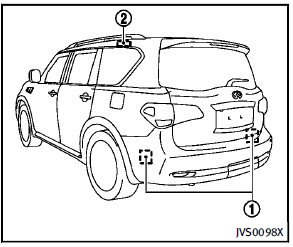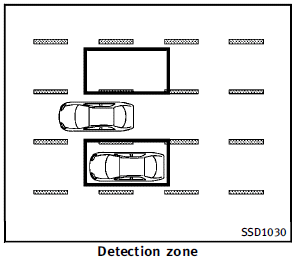Blind Spot Warning (BSW) system/Blind Spot InterventionTM system (if so equipped)

The Blind Spot Warning (BSW) and Blind Spot InterventionTM systems can help alert the driver of other vehicles in adjacent lanes when changing lanes.

The BSW system uses radar sensors 1 installed near the rear bumper to detect other vehicles beside your vehicle in an adjacent lane. In addition to the radar sensors, the Blind Spot InterventionTM system uses a camera2 installed behind the windshield to monitor the lane markers of your traveling lane.

The radar sensors can detect vehicles on either side of your vehicle within the detection zone shown as illustrated. This detection zone starts from the outside mirror of your vehicle and extends approximately 10 ft (3.0 m) behind the rear bumper, and approximately 10 ft (3.0 m) sideways. The BSW system operates above approximately 20 MPH (32 km/h). If the radar sensors detect a vehicle in the detection zone, the BSW/Blind Spot InterventionTM indicator light illuminates. If the driver then activates the turn signal, a chime will sound twice and the BSW/Blind Spot InterventionTM indicator light will flash. The Blind Spot InterventionTM system operates above approximately 37 MPH (60 km/h). If the system detects a vehicle in the detection zone and your vehicle is approaching the lane marker, the Blind Spot InterventionTM system provides an audible warning (three times), flashes the BSW/Blind Spot InterventionTM indicator light and slightly applies the brakes for a short period of time on one side to help return the vehicle back to the traveling lane. The Blind Spot InterventionTM system provides an audible warning and turns on or flashes the BSW/Blind Spot InterventionTM indicator light even if the BSW system is off.
 WARNING
WARNING
► The BSW and Blind Spot InterventionTM
systems are not a replacement for proper
driving procedure and are not designed
to prevent contact with vehicles or
objects. When changing lanes, always
use the side and rear mirrors and turn
and look in the direction you will move
to ensure it is safe to change lanes.
Never rely solely on the BSW or Blind
Spot InterventionTM system.
► Using the Blind Spot InterventionTM
system under some road, lane marker
or weather conditions could lead to
improper system operation. Always rely
on your own steering and braking
operation to avoid accidents.
► The BSW and Blind Spot InterventionTM
systems may not provide a warning or
brake control for vehicles that pass
through the detection zone quickly.
See also:
Ride & Handling
Though firmer than some in its segment — the Mercedes C-Class, for one — the
G37 rides comfortably, especially given our test car's 18-inch wheels and
lower-profile tires. Get on the interstate, a ...
Rapid air pressure loss
Rapid air pressure loss or a “blow-out” can
occur if the tire is punctured or is damaged
due to hitting a curb or pothole. Rapid air
pressure loss can also be caused by
driving on under-inflat ...
How to use SETTING button
How to use SETTING button
The display as illustrated will appear when the SETTING button is pushed.
For navigation settings, refer to the separate Navigation System Owner’s Manual. ...
